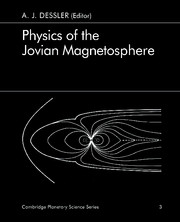Book contents
- Frontmatter
- Contents
- List of tables
- List of contributors
- Foreword
- Preface
- 1 Jupiter's magnetic field and magnetosphere
- 2 Ionosphere
- 3 The low-energy plasma in the Jovian magnetosphere
- 4 Low-energy particle population
- 5 High-energy particles
- 6 Spectrophotometric studies of the Io torus
- 7 Phenomenology of magnetospheric radio emissions
- 8 Plasma waves in the Jovian magnetosphere
- 9 Theories of radio emissions and plasma waves
- 10 Magnetospheric models
- 11 Plasma distribution and flow
- 12 Microscopic plasma processes in the Jovian magnetosphere
- Appendix A Symbols and acronyms
- Appendix B Coordinate systems
- Appendix C Jupiter and Io: selected physical parameters
- References
- Index
Appendix B - Coordinate systems
Published online by Cambridge University Press: 27 October 2009
- Frontmatter
- Contents
- List of tables
- List of contributors
- Foreword
- Preface
- 1 Jupiter's magnetic field and magnetosphere
- 2 Ionosphere
- 3 The low-energy plasma in the Jovian magnetosphere
- 4 Low-energy particle population
- 5 High-energy particles
- 6 Spectrophotometric studies of the Io torus
- 7 Phenomenology of magnetospheric radio emissions
- 8 Plasma waves in the Jovian magnetosphere
- 9 Theories of radio emissions and plasma waves
- 10 Magnetospheric models
- 11 Plasma distribution and flow
- 12 Microscopic plasma processes in the Jovian magnetosphere
- Appendix A Symbols and acronyms
- Appendix B Coordinate systems
- Appendix C Jupiter and Io: selected physical parameters
- References
- Index
Summary
Jovian coordinate systems are not complicated or cabalistic, but they are different. The following is a description of these systems, as relevant to this book. I will also try to explain why things are as they are. There is logic behind the present system, even if some of the results seem curious or unfortunate.
Jovian longitude conventions
Latitude and longitude coordinates are usually established relative to some solid surface. Because Jupiter does not have a solid surface (at least none that is visible through the clouds), arbitrary, but convenient, coordinate grids have been prescribed. A spin equator is rather easily made out from observations of cloud motion, so the direction of the planetary spin axis is determined with relatively good accuracy. However, the determination of longitude is an entirely different matter.
Longitudes on a planet are fixed relative to an arbitrary, but well defined, prime- or zero-longitude meridian. For example, the Earth's prime meridian is the one that passes through the central cross-hair of the transit telescope at the Greenwich Royal Observatory. Its location is unique, and it stays put. The selection of this meridian as the prime or zero-longitude meridian was initially arbitrary, but the selection, once made, fixes the longitude grid with precision. The problem immediately faced in establishing a Jupiter longitude system is that the mean rotation period of the clouds is a function of latitude. The equatorial region rotates faster than the temperate and polar regions, as is common in all planetary upper atmospheres.
- Type
- Chapter
- Information
- Physics of the Jovian Magnetosphere , pp. 498 - 504Publisher: Cambridge University PressPrint publication year: 1983
- 51
- Cited by



